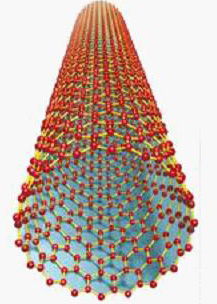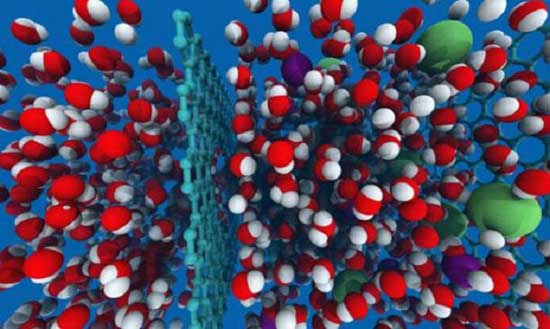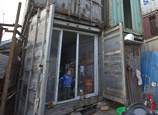
In 2004, two Russian physicists, Andrei Geim and Kostya Novoselov, were playing with a graphite block in Manchester England. They wanted to know if they could make thinner and thinner carbon flakes with the help of ordinary sticky tape. They peeled off a layer with the tape, then peeled another layer off the layer. They repeated the process until the layer is only a few atoms think. It is now just a lot of carbon atoms joined together. They called the material ‘graphene’. It is a chance discovery like the chance discovery of penicillin by Alexander Fleming. It has some surprise marvelous qualities and for that Geim and Novoselov were awarded the Nobel price in 2010.
Following are the properties of graphene, which is a two dimensional crystal of pure carbon:
* It can be made one atom thin with holes about one nanometer in size ( 1 nanometer is one billionth of a meter).
* It is 100 times stronger than steel. Take a square meter of graphene which is thousand times thinner than paper, it can support a cat on it. Yet it only weighs less than a gram.
* It is a good conductor of electricity and heat.
* it is stretchable and almost transparent. With good optical properties.
* It can stop helium gas to pass through and yet allow water to pass through. In fact, it is a good filter, can be a barrier to certain atoms and not others depending on size
* Because it is very thin and almost weightless, it can be a new generation of electronic components like small and fast computers, hyper-efficient solar panels, superfast mobile phones. These gadgets would be small, biodegradable, sustainable.
At present, graphene is not yet marketable, but many big companies are experimenting and expect to produce products soon. Here are some applications:
DRINKING WATER
Graphene Pores When water molecules (red and white) and sodium and chlorine ions (green and purple) encounter a sheet of graphene (pale blue, center) perforated by holes of the right size, the water passes through, but the sodium and chlorine of the salt are blocked. David Cohen-Tanugi/MIT
Lockheed company is working on a filter for desalination. Conventional desalination uses Reverse Osmosis (RO) where salt water is pumped across a membrane whereby water is filtered through and salt molecules are left behind. This process is electricity intensive. A graphene filter is 500 times thinner and 1000 stronger than the normal RO filter, therefore it takes 100 less energy for desalination. This process will use much less fossil or nuclear fuel and will be much cheaper for production of fresh water for the 700 million people in the world who at present do not have safe drinking water.
CONTROL POLLUTION
Chinese professor at Zhejiang university Gao Chao has created the world’s lightest material 0.16 milligram per cc - carbon graphene aerogel. It is good for tackling pollution. It mops up oil. Good for oil spill control. Can absorb 900 times its own weight.(People’s Daily Online,University creates world’s lightest material.
COMPUTERS
It is hoped that graphene will replace silicon chips. IBM and other computer companies are testing with graphene CPU( Central Processor Unit) which can execute 100GHz( 100 billion cycles per second) which is about 50% faster than previous transistors.
SATELLITES, PLANES AND CARS
Graphene has properties that provide light but superstrong composite materials for next generation satellites, planes and cars. it is obvious that reducing the weight of these vehicles has the great advantage of reducing the use of fossil fuels.
RUSTFREE CARS
Graphene repels water and is highly conductive. This combination keeps steel from coming into contact with water and delays the electrochemical reactions that oxidizes iron.
BUILDING MATERIALS
Because of its flexible nature,it is ideal for building material where graphene is incorporated into a polymer or a metal, where graphene is carrying the load
MILITARY EQUIPMENT
Blend graphene with a polymer produces a super strong fiber that could be used for bulletproof vests
NUCLEAR CLEANUP
Graphene can absorb radioactive waste. Bits of graphene oxide bind to radioactive contaminants transform them into large extractable clumps, This could help with clean up.
There are many more uses for graphene. The potential uses for graphene appear limitless. Two hundred years ago, Manchester witnessed the beginning of the industrial revolution with coal. Today we are witnessing a new revolution. It is definitely the wonder material that will transform the resource landscape of the 21st century.
"Gioietta Kuo, from Cambridge, Oxford and Princeton, is a research physicist specializing in energy problems. She has published over 100 articles in World Future Society, wfs.org, amcips.org and other worldwide think tanks. As well as in ‘ People’s Daily’ and ‘World Environment’ , Magazine of the Chinese Ministry of Environmental Protection, and others in China. She can be reached at <kuopet@comcast.net.>"
















 Death toll rises to 14 in central China hotel fire
Death toll rises to 14 in central China hotel fire


![]()
